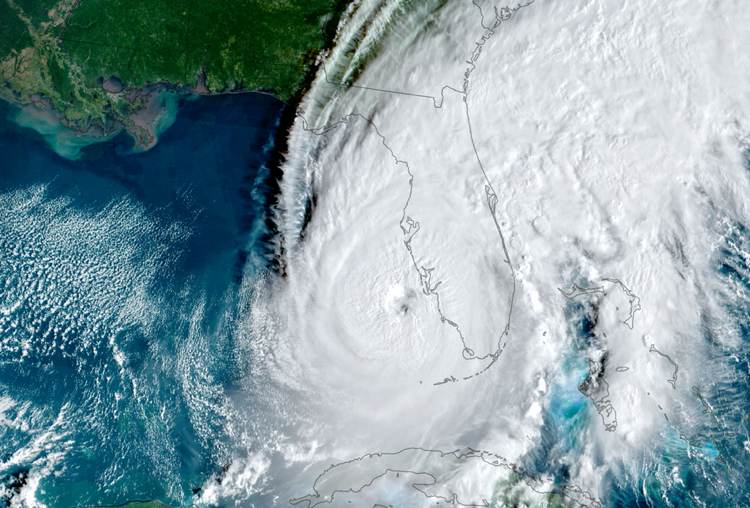Cat bond market’s actual losses from Ian could be half the initial hit

Realised losses from hurricane Ian for the catastrophe bond market could end up being as little as half the initial, and still current, mark-to-market decline in the outstanding cat bond market, sources have told Artemis and our analysis also backs this up.
We reported soon after major hurricane Ian’s landfall in Florida that the Swiss Re Global Cat Bond Index dropped considerably, by 10%, right after the storm.
With the catastrophe bond market having over $35 billion of risk capital outstanding (we make it $35.62 billion if we exclude private cat bonds from our chart on the outstanding cat bond market), the fall in that key index could imply a $3.5 billion cat bond market mark-down, or thereabouts depending on how big a market is reported by different entities.
After that, our initial analysis on the potential impact of hurricane Ian to cat bond funds (published October 4th) suggested a range of -3% to -9% returns would be reported, which seems to have stacked up against all the data available so far.
Additional analysis by Artemis, of cat bond pricing sheets and cat model outputs, suggested the cat bond market was hit by a mark-to-market loss of between $1.6 billion and $3.6 billion after the hurricane Ian marking down of secondary cat bond positions.
Then, the Plenum CAT Bond UCITS Fund Indices saw an average decline of just over -5% at the first calculation point after hurricane Ian’s landfall.
As we explained more recently, these cat bond fund indices fell again a week later, now being down on average by just over -6% since Ian’s landfall.
But, as we’ve also been reporting, the marking down of the cat bond market has included broad reductions in price across almost all cat bond names, even those not exposed to actual losses from hurricane Ian.
In an article earlier this week, we reported on the latest analysis by Lane Financial LLC about the possible cat bond market impact of hurricane Ian.
Lane Financial said that, after analysing pricing sheets, the data implies to them a roughly $1.906 billion cat bond market loss is possible from hurricane Ian.
But Lane’s analysis also identified price declines across numerous other outstanding catastrophe bonds.
Now, our insurance-linked securities (ILS) and cat bond market sources are suggesting that as much as nearly 50% of the initial mark-to-market hit could be recovered, or is in cat bonds not exposed to actual losses from Ian.
Sources suggest the ultimate cat bond market loss is likely to fall within a range of between $1 billion and $2 billion, with uncertainty aplenty in certain names such as the NFIP’s FloodSmart Re cat bonds and Citizens Everglades Re, as well as the potential for loss creep from Ian, driving whether losses end up nearer the bottom of that range, or towards the higher end.
Going back to the movement of the cat bond market index, as calculated by reinsurance company Swiss Re, the Global Cat Bond Index, it is down more than 10% since hurricane Ian.
So that implies a mark-to-market decline, or loss after the storm, of roughly $3.5 billion (depending on how you size the market).
Then, if the actual losses are closer to Lane Financial ($1.9bn) or our sources’ estimates (between $1bn and $2bn), then it seems likely somewhere between 40% to 50% of the initial hurricane Ian hit to the cat bond market may either be recovered, or is currently only attributed to bonds that cannot actually face a principal loss from this event.
Implying that actual cat bond market losses from hurricane Ian could turn out to be almost as low as half the initial mark-to-market declines that have been seen and we’ve reported.
Lane Financial’s analysis also looked at the bonds that were marked down but not exposed to hurricane Ian, with this indicating the higher levels of pricing the cat bond issuance market may need to deliver in future to keep its investors satisfied.
Some of this decline may also be earned back over future weeks, as the true impact of hurricane Ian and also Ian’s implications for reinsurance and retrocession renewal rates going forwards are better understood.
Catastrophe bond pricing sheets tend to be marked very conservatively and cat bond fund managers are equally as conservative, when it comes to ensuring they adequately mark-down positions for any potential losses that may occur.
Therefore, it’s natural to assume some recovery will come, but the gap between market-wide decline of the index, at around 10%, and many cat bonds funds being closer to 5%, also supports an expectation that the eventual loss to the catastrophe bond market could be a good deal lower than pricing data currently suggests.
It’s going to take some weeks for this to become clearer. But we do expect to see some level of recovery in cat bond indices and cat bond funds as this all plays out, which we will of course report as any news emerges.
This is as long as we don’t see any significant surprises to the downside with hurricane Ian, that elevate the industry loss and tip a number of additional cat bonds into the bucket of those anticipated to be facing drawdowns of their principal.
With such a wide-range of industry loss estimates still, with a mid-point of estimates seemingly between $55 billion and $59 billion, but the high-end still close to the mid-$70bn’s, there is plenty of room for a move to the downside, especially as the claims and litigation process in Florida unfolds.
But even with a move to the downside, some cat bond market recovery is to be expected, as ultimate losses are unlikely to reach the current mark-to-market decline, even in the worst scenario (at least, that is how it seems at this still early stage).
Finally, it’s important to note that, for cat bond funds, any recovery wouldn’t be evenly felt across the market.
Some cat bond funds are more concentrated strategies, with more Florida exposure, while some other cat bond funds take a higher-risk and return approach to investing, while its also true that very few cat bond portfolios have a broad-enough spread of the market to closely match these market-wide price movements.





